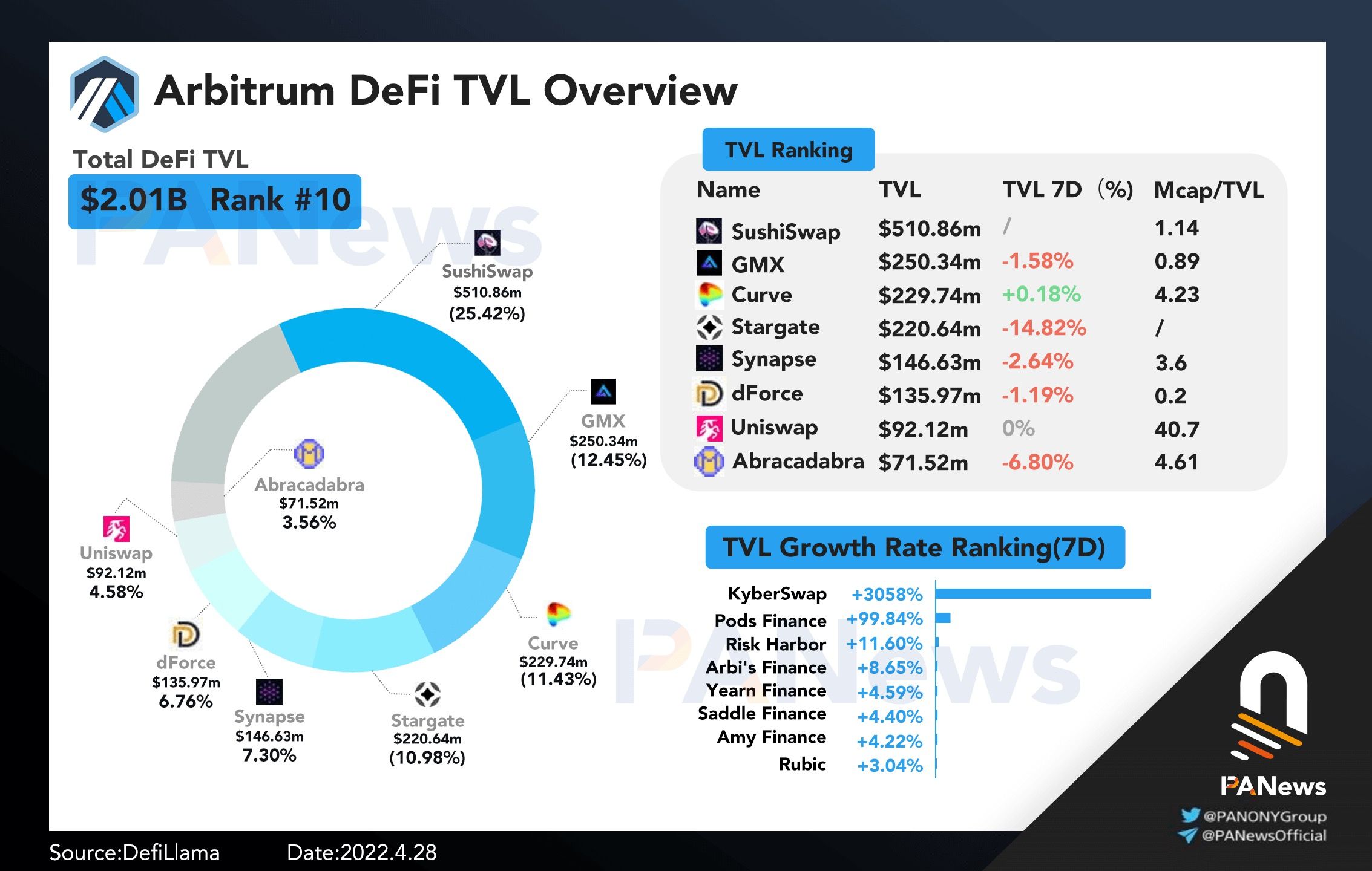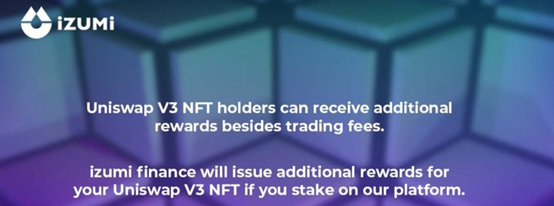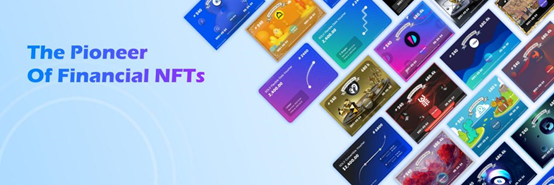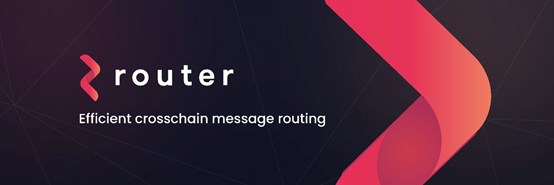A quick overview of the basic situation of the new member of the Arbitrum ecosystem
Author: PANews
As a key part of the Ethereum upgrade, Layer2 scaling solutions have received significant attention. In the context of a generally sluggish cryptocurrency market in recent months, the TVL of Layer2 leader Arbitrum has grown against the trend. According to DefiLlama data, as of April 28, its TVL has increased by approximately 39.6% over the past three months. According to information from the Arbitrum official website, there are currently nearly 170 projects in the Arbitrum ecosystem, covering areas such as DeFi, NFTs, cross-chain, oracles, and wallets, including top DeFi projects in the Ethereum ecosystem like Curve, Uniswap, SushiSwap, and AAVE.

Overview of Arbitrum ecosystem DeFi locked value
According to PANews, Arbitrum currently accounts for about 56.3% of the total TVL of Layer2. Recently, it has been "very active," with approximately 13 new Dapps and protocols added to the ecosystem in the past month and a half, mainly in the fields of DeFi, NFTs, cross-chain, privacy, and wallets. This article will introduce the basic situation of the new members in the Arbitrum ecosystem one by one.
DeFi
izumi Finance: Liquidity Optimization Protocol

izumi Finance is a liquidity optimization protocol built on Uniswap V3, proposing "Programmable Liquidity as a Service" (Laas). By concentrating liquidity within specific price ranges, it enhances liquidity supply efficiency and mining rewards. Its investors include IOSG Ventures, Fenbushi Capital, Hashkey Capital, and NGC Ventures.
Based on the Uniswap V3 model, izumi Finance segments liquidity providers in the liquidity mining process into roles such as project parties and professional market makers, optimizing for their respective needs. For example, izumi Finance allows project parties to limit liquidity mining rewards to a specific price range, attracting liquidity to this range through incentive measures to ensure relative stability of token prices. To attract market makers, izumi Finance offers a liquidity yield plus feature, allowing market makers to stake their LP tokens after providing liquidity to earn additional rewards (the specific bonus ratio is set by the project party), generally settled in project tokens.
Project official website link: https://izumi.finance/home
YIN Finance: Liquidity Management Protocol

YIN Finance is a decentralized liquidity management protocol aimed at the Uniswap V3 market, with investors including Fenbushi Capital, SevenX Ventures, and Shima Capital. Users can subscribe to "CHI," a proactive liquidity management strategy provided by YIN Finance, to achieve better capital management. Each CHI represents a different liquidity management strategy, and once users subscribe to CHI, their assets are converted into the liquidity described by the corresponding CHI.
YIN Finance also provides each user with a smart vault called "YANG," where all asset operations are executed, allowing users to retain control over their assets, thus ensuring asset security. In the future, YIN Finance will launch the "Grandmaster" feature, allowing users to lend out underutilized assets for others to use, enhancing liquidity and returns.
Project official website link: https://yin.finance/
AAVE V3: Enhancing Capital Efficiency and Security
The AAVE protocol V3 version was officially launched on March 17, aiming to enhance cross-chain functionality while improving capital efficiency and security. It currently supports Polygon, Arbitrum, Avalanche">Avalanche, Fantom, Harmony, and Optimism. As of April 21, its TVL was approximately $1.21 billion. In addition to gas fee optimization and risk management improvements, the new features of AAVE V3 mainly include:
Cross-chain asset flow. AAVE V3 allows users' assets to move seamlessly between markets across different networks, enabling users to transfer liquidity provided from one network to another, thus supporting cross-chain lending. For example, users can deposit funds in Polygon, then borrow on Arbitrum, and finally repay on Avalanche.
Efficient mode (eMode). AAVE V3 categorizes different assets into specific categories, usually referring to a group of assets pegged to the same underlying asset, such as stablecoins pegged to the US dollar (like USDC, USDT) or assets pegged to ETH (like ETH, stETH). When borrowing assets of the same category as the user's collateral, users can obtain higher borrowing capacity.
Isolation mode. In AAVE V3's isolation mode, users can only borrow specific types of assets (such as stablecoins, ETH, WETH) and cannot use other assets as collateral simultaneously, limiting the exposure and risk of newly listed assets to the protocol.
Project official website link: https://aave.com/
Vovo Finance: Structured Product Protocol

Vovo Finance is a structured product protocol in the DeFi space that combines different financial instruments to provide users with various products to meet different risk preferences. Currently, Vovo Finance has launched a "protective" product suitable for low-risk preferences, achieved by integrating Curve and GMX (perpetual contract protocols). The product has been audited by PeckShield and Hashloak and is currently in alpha mode.
In simple terms, the "protective" product allows users to deposit funds into the protocol's insurance pool, where the protocol automatically deposits the funds into Curve to earn yields, collecting rewards once a week, then converting the earnings into USDC and trading on GMX. It currently supports creating 10x long and short positions for BTC and ETH, and the protocol will periodically collect trading profits into the corresponding vault (if profitable). In this mode, the funds deposited in Curve by users will not be affected.
Project official website link: https://vovo.finance/
Yield Protocol: Fixed Rate Lending Protocol
Yield Protocol is a DeFi protocol for fixed-rate and term lending, aimed at addressing the issue of interest rate fluctuations in current lending protocols. It is incubated and invested by the well-known institution Paradigm, with other investors including Framework Ventures, CMS, and DeFi Alliance. Currently, it supports tokens including ETH, DAI, and USDC.
Yield Protocol has launched a fyToken certificate for the deposit function, allowing users to redeem the underlying asset one-to-one after a predetermined maturity date. fyTokens are similar to zero-coupon bonds; they do not pay interest but are traded at a discount, allowing users to redeem them at full face value upon maturity for profit. For example, if you have a fyDai token, you can exchange it for one Dai after the maturity date.
Project official website link: https://yieldprotocol.com/
QiDao Protocol: Over-Collateralized Lending Protocol
QiDao Protocol is an over-collateralized lending protocol native to the Polygon ecosystem. Currently, supported collateral assets include MATIC, WETH, WBTC, LINK, AAVE, CRV, etc., with a collateralization ratio of 130% to 150%, depending on the collateral asset. After users deposit collateral, they can borrow the stablecoin MAI minted by the system. The current borrowing interest rate is 0%, and the protocol only charges a repayment fee of 0.5% of the total debt when users repay, which is priced in collateral tokens.
According to DeFi Llama data, as of April 28, the TVL of the QiDao protocol is approximately $340 million, and it currently supports nine chains including Polygon, Fantom, Avalanche, Arbitrum, Cronos, and Harmony.
Project official website link: https://www.mai.finance/
Superfluid: Cash Flow Protocol
Superfluid is a DeFi project focused on cash flow, allowing different funds to flow in and out of the same account simultaneously, thereby improving capital efficiency for users while reducing the number of transactions users need to sign and gas fees. Its investors include Multicoin Capital, DeFiance Capital, Delphi Digital, and Semantic Ventures.
Superfluid is a network composed of interwoven value streams from many assets, which can operate synchronously. For example, Jack receives a reward of 100 USDT daily from his contribution to the DAO">DAO community, where 10 USDT is used for regular BTC investments, 20 USDT for regular ETH investments, 20 USDT for charitable donations, and the remaining 50 USDT for savings. These different operations can occur simultaneously without additional gas consumption.
Project official website link: https://www.superfluid.finance/home
DeFIL: Filecoin Ecosystem Lending Platform
DeFIL (Decentralized Finance of Filecoin) is a lending platform developed based on Ethereum within the Filecoin ecosystem, aiming to create a decentralized platform that combines FIL mining pools with DeFi to increase the liquidity of the FIL token. It has now upgraded to DeFIL 2.0, which will integrate various elements such as computing power NFTs, perpetual computing power tokens, DeFi lending, liquidity mining, and DAO governance, providing users with more diverse application scenarios. Its investors include the IPFS ecosystem fund, Distributed Capital, FBG Capital, and Gate Labs.
Project official website link: https://defil.org/
NFT
Solv Protocol: Financialization of NFTs

Solv Protocol is a project that applies NFTs to financial scenarios by transforming tokens and other digital assets into NFT-style certificates with financial attributes, supporting quantitative operations such as splitting and merging to achieve widespread application of NFT certificates in the financial field. Its investors include Binance Labs and IOSG Ventures.
Currently, Solv Protocol has launched Vesting Vouchers (entitlement certificates) and Convertible Vouchers (convertible certificates). The entitlement certificates are mainly used in token distribution management, especially for first-market token management, requiring parameters such as expiration date, token quantity, and entitlement type to be set. This is equivalent to the project party packaging the distribution and unlocking of tokens into an NFT that investors can directly purchase and trade.
Convertible vouchers are akin to convertible bonds in the DeFi space, requiring parameters such as expiration date, face value, and bond range (price range of the underlying token) to be set. Upon maturity, if the token price is within the predetermined bond range, the convertible voucher will execute like a zero-coupon bond, meaning the project party will pay the face value in stablecoins to redeem the bonds held by investors. If the token is outside this range, the convertible voucher will automatically convert into a redemption voucher for investors to claim the underlying token. This design protects the project from excessive token dumping during the unlocking of early investors' allocations.
Project official website link: https://solv.finance/home?linktree
Privacy Payments
Umbra: Creating Invisible Addresses to Support Privacy Payments
The Umbra protocol focuses on privacy payments by creating invisible addresses, allowing payers to send relevant tokens to an address controlled by the receiver, without any third party knowing who the receiver is, effectively transmitting the transaction to a new, unused address. It currently supports Ethereum, Polygon, Arbitrum, and Optimism.
Unlike Tornado Cash, which is an on-chain mixer using zero-knowledge proof technology, where everyone's funds are pooled, thus breaking the link between deposit and withdrawal addresses to achieve privacy protection, Umbra does not use zero-knowledge proof technology and does not break the link between sending and receiving addresses. Everyone can see who sent the funds and the address to which the funds were sent, but this receiving address has never been used on-chain, so no external observer can know who controls it, making it suitable for privacy payments between two individuals or merchants.
Project official website link: https://app.umbra.cash/
Cross-Chain
Stargate Finance: Solving the Cross-Chain Trilemma

Stargate Finance is the first product launched by the LayerZero protocol for full-chain interoperability, addressing the cross-chain challenges of "instant finality," "unified liquidity," and "native assets." As of April 28, its TVL is approximately $1.7 billion. PANews previously provided a detailed introduction in the cross-chain bridge Stargate practical experience and will not elaborate further here.
Project official website link: https://stargate.finance/
Router Protocol: Cross-Chain Protocol Supporting Asset Swaps

Router Protocol is a cross-chain protocol that supports asset swaps, allowing DAI on Arbitrum to be directly transferred to USDC on Avalanche. Additionally, Router Protocol will support developers in building cross-chain Dapps on its protocol in the future. Currently, the Router protocol supports seven chains including Ethereum, Arbitrum, Avalanche, Polygon, and BSC, with investors including Coinbase Ventures, Alameda Research, and Polygon.
Project official website link: https://www.routerprotocol.com/
Wallets
BitKeep Wallet: Multi-Chain Crypto Wallet
BitKeep is a decentralized multi-chain crypto wallet dedicated to providing global users with secure and convenient one-stop digital asset management services. It currently serves nearly 5 million users in 168 countries, supporting over 40 main chains, including Ethereum, BSC, Terra, Solana, Avalanche, Fantom, Near, Arbitrum, and over 8,000 Dapps, as well as more than 4,500 types of crypto assets. Its investors include Dragonfly Capital, A&T Capital, and SevenX Ventures.
Project official website link: https://bitkeep.com/
With the gradual development and maturation of Layer2 scaling solutions, competition among Layer2s will intensify. After Optimism recently issued tokens, whether Arbitrum will also airdrop is worth our attention. In the future, PANews will continue to monitor the development of the entire Arbitrum ecosystem. Please download the APP and follow the author for ongoing updates.










